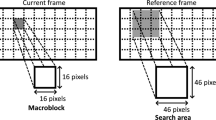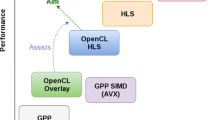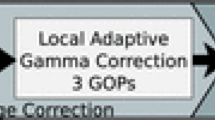Abstract
This paper describes flexible tools and techniques that can be used to efficiently design/generate quite a variety of hardware IP blocks for highly parameterized real-time video processing algorithms. The tools and techniques discussed in the paper include host software, FPGA interface IP (PCIe, USB 3.0, DRAM), high-level synthesis, RTL generation tools, synthesis automation as well as architectural concepts (e.g., nested pipelining), an architectural estimation tool, and verification methodology. The paper also discusses a specific use case to deploy the mentioned tools and techniques for hardware design of an optical flow algorithm. The paper shows that in a fairly short amount of time, we were able to implement 11 versions of the optical flow algorithm running on 3 different FPGAs (from 2 different vendors), while we generated and synthesized several thousand designs for architectural trade-off.

















Similar content being viewed by others
References
Wang, R., Hamilton, T.J., Tapson, J., van Schai, A. (2014). An FPGA design framework for large-scale spiking neural networks. In Proceedings of IEEE international symposium on circuits and systems (ISCAS).
Nurvitadhi, E., Weisz, G., Wang, Y., Hurkat, S., Nguyen, M., Hoe, J.C., Martínez, J. F., Guestrin, C. (2014). Graphgen: An FPGA framework for vertex-centric graph computation. In Proceedings of IEEE international symposium on field-programmable custom computing machines (FCCM).
SDSoC development environment. https://www.xilinx.com/products/design-tools/software-zone/sdsoc.html. Accessed: 2017-11-12.
SoCEDS getting started. http://www.alterawiki.com/wiki/SoCEDSGettingStarted. Accessed: 2017-11-12.
Liu, C., Ng, H. -C., So, H.K.-H. (2015). QuickDough: A rapid FPGA loop accelerator design framework using soft CGRA overlay. In Proceedings of international conference on field programmable technology (FPT).
Fowers, J., Liu, J., Stitt, G. (2014). A framework for dynamic parallelization of FPGA-accelerated applications. In Proceedings of international workshop on software and compilers for embedded systems (SCOPES).
Kalms, L., & Göhringer, D. (2017). Exploration of OpenCL for FPGAs using SDAccel and comparison to GPUs and multicore CPUs. In Proceedings of international conference on field programmable logic and applications (FPL).
Intel FPGA SDK for OpenCL. https://www.altera.com/products/design-software/embedded-software-developers/opencl/overview.html. Accessed: 2017-11-12.
Ugurdag, H.F. (2013). Experiences on the road from EDA developer to designer to educator. In Proceedings of east-west design & test symposium (EWDTS).
Desmouliers, C., Oruklu, E., Aslan, S., Saniie, J., Vallina, F.M. (2012). Image and video processing platform for field programmable gate arrays using a high-level synthesis. IET Computers & Digital Techniques, 6(6), 414–425.
Sahlbach, H., Thiele, D., Ernst, R. (2017). A system-level FPGA design methodology for video applications with weakly-programmable hardware components. Journal of Real-Time Image Processing, 13(2), 291–309.
Philip, J.T., Samuvel, B., Pradeesh, K., Nimmi, N.K. (2014). Rimcom: Raster-order image compressor for embedded video applications. In Proceedings of international conference on emerging research areas: magnetics, machines and drives (AICERA/iCMMD).
Middlebury optical flowv benchmark database. http://vision.middlebury.edu/flow/eval/results/results-e1.php. Accessed: 2017-11-12.
Werlberger, M., Trobin, W., Pock, T., Wedel, A., Cremers, D., Bischof, H. (2009). Anisotropic Huber-L1 Optical Flow. In Proceedings of British machine vision conference (BMVC).
Büyükaydın, D., & Akgün, T. (2015). GPU implementation of an anisotropic Huber-L1 dense optical flow algorithm using OpenCL. In Proceedings of international conference on embedded computer systems: Architectures, modeling, and simulation (SAMOS).
Levent, V.E. (2015). FPGA based hardware platform for video processing, Master’s thesis, Yildiz Technical University. YOK Thesis No: 406560.
Hwang, C.-T., Hsu, Y.-C., Lin, Y.-L. (1991). Scheduling for functional pipelining and loop winding. In Proceedings of ACM/IEEE design automation conference (DAC), pp. 764–769.
Parhi, K.K. (1999). VLSI digital signal processing systems: Design and implementation. New York: Wiley.
Guzel, A.E., Levent, V., Tosun, M., Ozkan, M.A., Akgun, T., Erbas, C., Ugurdag, H.F. (2016). Using high-level synthesis for rapid design of video processing pipes. In Proceedings of East-West Design & Test Symposium (EWDTS).
Vivado design suite user guide: High level synthesis (ug902 v2014.3). http://www.xilinx.com/support/documentation/sw_manuals/xilinx2014_3/ug902-vivado-high-level-synthesis.pdf. Accessed: 2017-11-12.
Buyukmihci, M., Levent, V., Guzel, A., Ates, O., Tosun, M., Akgun, T., Erbas, C., Goren, S., Ugurdag, H. (2016). Output domain downscaler. In Proceedings of international symposium on computer and information sciences (ISCIS).
Jacobsen, M., Richmond, D., Hogains, N., Kastner, R. (2015). Riffa 2.1: A reusable integration framework for fpga accelerators. In ACM Transactions on Reconfigurable Technology and Systems (TRETS), vol. 8, no. 4, article no. 22.
Reinhard, E., Ashikhmin, M., Gooch, B., Shirley, P. (2001). Color transfer between images. IEEE Computer Graphics and Applications, 21(5), 34–41.
Toet, A. (2003). Natural colour mapping for multiband nightvision imagery. Information Fusion, 4(3), 155–166.
Janik, I., Tang, Q., Khalid, M. (2015). An overview of altera sdk for opencl: A user perspective. In Proceedings of IEEE Canadian conference on electrical and computer engineering (CCECE), pp. 559–564.
Acknowledgements
This work was supported by the Scientific and Technological Research Council of Turkey (TÜBİTAK) through project no. 114E343 as well as European Union’s Artemis Joint Undertaking as part of project named ALMARVI (Grant Agreement 621439).
Author information
Authors and Affiliations
Corresponding author
Additional information
Publisher’s Note
Springer Nature remains neutral with regard to jurisdictional claims in published maps and institutional affiliations.
Rights and permissions
About this article
Cite this article
Levent, V.E., Guzel, A.E., Tosun, M. et al. Tools and Techniques for Implementation of Real-time Video Processing Algorithms. J Sign Process Syst 91, 93–113 (2019). https://doi.org/10.1007/s11265-018-1402-7
Received:
Revised:
Accepted:
Published:
Issue Date:
DOI: https://doi.org/10.1007/s11265-018-1402-7




